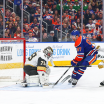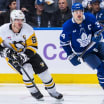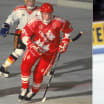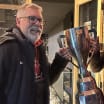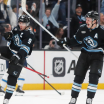Drew Doughty carried the Stanley Cup around the ice at Staples Center, having achieved his dream when the Los Angeles Kings defeated the New Jersey Devils in Game 6 of the 2012 Final.
Smiling and cheering, he looked to pass the Cup to his beaming defense partner. On that day, it was Rob Scuderi.
But it very nearly was another player, one who was available 11 picks after the Kings took Doughty No. 2 in the 2008 NHL Draft, and who could have given Los Angeles two franchise defensemen from that class.
2008 NHL Draft marked by selections of Stamkos, Doughty, Karlsson
Inside story of first round that made big impact on League
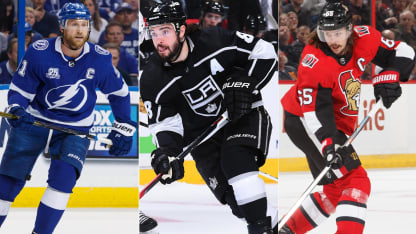
© Getty Images
RELATED: [2008 Redraft: Stamkos remains No. 1 | Complete 2018 NHL Draft coverage]
Erik Karlsson was there for the Kings to select, but they passed on him.
"Obviously [Karlsson] should have been the pick at 13," Kings director of amateur scouting Mark Yannetti said. "We took the wrong player."
Karlsson instead went to the Ottawa Senators at No. 15. It was part of a wild first round that included big hits and misses, almosts and what-ifs, and a flurry of trades.
Twenty-six of the 30 players selected at Scotiabank Place in Ottawa on June 20, 2008, have played in the NHL, and 18 have played at least 200 games. The list includes a Rocket Richard Trophy winner, two Norris Trophy winners and two Stanley Cup champions.
"You can never expect a draft to be that deep," Senators general manager Pierre Dorion said. "You're dealing with 17-, 18-year-olds. There's a lot of circumstances, variables. It's a credit to those guys that 26 guys played at least a game."
About the only certainty was what the Tampa Bay Lightning would do with the No. 1 pick. They were so set on taking center Steven Stamkos from Sarnia of the Ontario Hockey League that, not long after winning the draft lottery, a popular two-word, multiplatform advertising campaign was unveiled: "Seen Stamkos?"
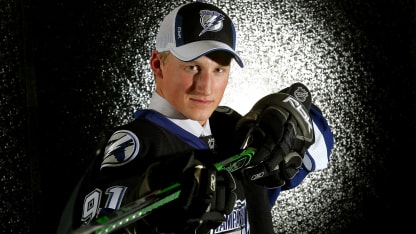
© Getty Images
Jay Feaster, the Lightning GM at the time, said the campaign killed any chance he had to gauge interest in trading the No. 1 pick, but barring a mind-blowing offer, a move wasn't happening. Stamkos had been atop the Lightning's internal rankings since their meetings following the 2007 NHL Draft.
"Having a player that we thought could be a franchise player at that point and having him at that position," Feaster said, "we were focused on that very, very early."
The selection of Doughty at No. 2, on the other hand, was fraught with difficulty for the Kings leading up the draft.
Here is the inside story of what happened, and didn't, that day, the events of which are reverberating through the NHL a decade later.
* * *
After selecting Doughty at No. 2, the Kings were on the clock a second time at No. 13, a pick they had acquired in a trade with the Buffalo Sabres moments earlier.
Yannetti said the plan was to add depth on defense.
"At that time we were building, and our philosophy was, you build from the blue line out," he said. "So we build [defense], then center, then goalie."
Among the defensemen left on the board at No. 13 was Karlsson, who had measured 5-foot-10 1/2, 157 pounds during the 2008 NHL Scouting Combine.
Karlsson's offensive skills were unquestioned; he had 37 points (13 goals, 24 assists) in 38 games for Frolunda in Sweden's junior league, and seven assists in six games for Sweden at the 2008 IIHF World Under-18 Championship. But size was an issue, as was his suspect defensive play.
"People really, really liked Erik Karlsson for his offensive ability, scary vision and hands, all those offensive attributes," an amateur scout for an NHL team said. "Could be very interesting in his own end, in the neutral zone, in the sense of stepping up and making wrong reads. It's almost like what made him good also was a bit of a knock on him, because he had that fantastic offense, because he was so confident with the puck as a 17-year-old. He would turn it over, [commit] bad pinches, bad reads. High risk/high reward. … Is he going to be a power-play specialist? And can he eat those (5-on-5) minutes?"
Yannetti said Los Angeles considered picking Karlsson at No. 13 but that there was no consensus among the scouts on whether he'd develop physically.
"You couldn't watch him play and not be awed by his skating and his skill," Yannetti said. "But he was 5-10 and there wasn't much to him. … Would the Kings have thought he was going to be a D1 (No. 1 defenseman)? No, we didn't think he'd be a D1. Did the Kings think he'd be a D3? Yes, and a good D3."
Instead of Karlsson, Los Angeles selected a more physical player, Colten Teubert (6-3, 185) from Regina of the Western Hockey League. He never played for the Kings; he was traded to the Edmonton Oilers on Feb. 28, 2011, and has spent the past five seasons in Germany.
Yannetti said the Kings picked Teubert because of his size and strength, two elements the organization felt it was lacking.
"Immediate need changes," said Yannetti, who joined the Kings in 2006-07, soon after Dean Lombardi was hired as GM. "We went from having the worst defensive depth in the League when we arrived to the best defensive depth in the League in the span of three years. We went from being a team that was pushed around quite a bit in our first few years to a team that was not pushed around ever. You fill this immediate need in two areas that by the time a player is [NHL-ready], you don't have that need anymore. Then you skip over better players to address a certain need."
Los Angeles wasn't the only team to miss on Karlsson. The Nashville Predators had the No. 15 pick and a history of drafting and developing top-end defensemen. The 2007-08 Predators featured Shea Weber (second round, No. 49, 2003), Ryan Suter (first round, No. 7, 2003) and Dan Hamhuis (first round, No. 12, 2001) as the core of their defense.
This time, however, Nashville filled an organizational need. After selecting Colin Wilson, a player the Predators felt was going to be an elite center, at No. 7, the plan was to find a No. 1 goaltender.
The Predators expected that goaltender to be available lower in the first round, so when the Senators offered the No. 18 pick plus a third-round selection in the 2009 NHL Draft, they agreed to the trade.
Ottawa had one player in mind when it approached Nashville.
"At that point in time we were going to move up for one player and one player only and that was Erik Karlsson," said Dorion, then in his first season as director of amateur scouting.
Dorion said Karlsson stood out to him during a tournament that February, and that watching him play at the U-18s two months later cemented his opinion.
"What we saw was outstanding skill," he said. "He was someone that when he had the puck he was almost magical. … When it came to watching him, he was someone that had a dynamic quality to him. But there were a lot of things he needed to get better [at]. His backward skating wasn't the best at that time. But what really stood out to me was there was a game against Canada at the Under-18s and he wasn't afraid to be the guy even though everyone else was 20, 30 pounds heavier than him. He still went in and got involved and made things happen."
Dorion still had to sell GM Bryan Murray on Karlsson.
"He goes, 'Pierre, how long do you want to work for me?'" Dorion said. "I said, 'A long time.' He goes, 'You want us to take a 5-foot-10, 159-pound defenseman?' I said 'Yes, we've got to take him and I want to work for you for a long time. Bryan, this is the guy we should be taking.'"
Karlsson said he was surprised when his name was called by the Senators. He had heard through his agent that the Anaheim Ducks, with the No. 17 pick, were interested.
"We thought that they were going to pick me," Karlsson said.
Karlsson didn't need long to get comfortable with the Senators, as they found out when he assumed a place at their draft table on the second day.
"He'd introduce himself to every pick, 'I'm Erik Karlsson, I'm going to be your teammate, '" Dorion said. "The confidence that he brought … there was just a presence about Erik when he came and sat down at our table."
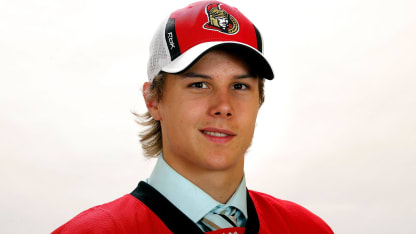
© Getty Images
At No. 18 the Predators got their goaltender, Chet Pickard from Tri-City of the WHL.
"It's very rare that we would take a player that is positional instead of taking what we think is the best player," said Paul Fenton, then Nashville's assistant GM and now GM of the Minnesota Wild. "We felt we had to eliminate a need that we had not been able to fill in the draft for a while. (Goalie) Pekka (Rinne) was still in the up-and-coming [stage] and we decided to take a shot with Pickard."
Pickard never reached the NHL and has played the past four seasons in Europe.
Rinne, selected in the eighth round (No. 258) of the 2004 NHL Draft, became the Predators' No. 1 goalie in 2008-09. He is a four-time Vezina Trophy finalist and Nashville's all-time leader in wins (311) and shutouts (51).
"Our history of taking defensemen was great," Fenton said. "We would have taken Erik Karlsson probably if we hadn't traded back. That's the things that happen at the draft."
The Predators did get a top-end defenseman at the 2008 draft. They traded their second-round pick (No. 46) and a third-round pick (No. 76) to the Phoenix Coyotes to move to No. 38 and select Roman Josi in the second round.
* * *
Though the Kings missed on Karlsson, they felt they'd hit with Doughty.
Doughty, who was playing for Guelph of the OHL, was one of several top-rated defenseman the Kings had to choose from, among them Zach Bogosian of Peterborough of the OHL, teammates Tyler Myers and Luke Schenn of Kelowna of the WHL, and Alex Pietrangelo of Niagara of the OHL.
Yannetti said the scouting staff took the top eight defensemen in its internal rankings, created a tournament bracket and voted to determine the winner of each hypothetical matchup, with Doughty emerging as the winner.
"You almost use the word savant for him in terms of the way he instinctually processed things," he said. "It was a unique thing. … When you see something that special, generational, it stands out."
Despite all that talent, Los Angeles wasn't sure about Doughty and had serious questions about his fitness.
After Doughty's season ended with Guelph, Yannetti, Lombardi and current assistant GM Michael Futa, then co-director of amateur scouting with Yannetti, met with Doughty and his parents at the family home in London, Ontario.
They had what Yannetti called "a very frank and at times uncomfortable conversation."
"I think it was [Futa] who had said Tampa Bay should be in here talking about you at No. 1 and the only reason they're not is because of the fitness," Yannetti said. "I don't think it's a secret. I don't think he was No. 2 on any lists, he wasn't a consensus. There were a lot of question marks about him."
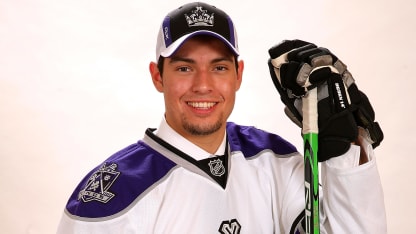
© Getty Images
Doughty said he wasn't offended by the tone the Kings took during the meeting.
"I knew I wasn't in the greatest shape I could be in," he said. "That was obvious. We didn't take it harsh or anything like that. We just took it as a wake-up call, like in order to be a pro you've got to act like a pro, and do things that pros do."
Los Angeles also had in-depth meetings with Bogosian, Pietrangelo and, to a lesser extent, Schenn. Yannetti said the No. 2 pick in 2008 represents the most work he has put into any draft choice since he became an NHL amateur scout in 2004.
"The second pick, that's a $50-million-or-more pick if you get it right or wrong," he said. "It was laid out to Drew that we can't consider drafting a guy that doesn't take his fitness seriously."
The meeting gave the Kings their first glimpse of Doughty's competitiveness.
"Drew was prideful in the right kind of way," Yannetti said. "When his pride was hurt that way, he was going to show everybody. … Drew rises to challenges in a way that most people do not."
Doughty said the meeting with the Kings led to major lifestyle changes.
"I worked out as hard as I possibly could for two months and lost like 30 pounds," he said. "Then I went into the combine and just tried to do my best. I still wasn't the best, I was probably middle of the pack, but I did a lot better than I would've had I not focused on it for those two months."
That performance was enough for Los Angeles.
"He passed every test there with flying colors," Yannetti said. "And he wasn't close to where he needed to be. But he had shown that he was taking it seriously. He had shown he had improved and he had shown he was addressing it. It was obvious to us when we left his house and then it was solidified almost every day from the combine on."
The Kings were so sure about Doughty that Yannetti said they would have taken him, rather than Stamkos, if they had the No. 1 pick.
"Any fears we had going into that meeting at his house were allayed, and if not at that moment they were certainly put to rest before the draft," he said.
With Doughty off the board, the Atlanta Thrashers chose Bogosian at No. 3, ahead of Pietrangelo.
"Skating was becoming one of the prime assets you were looking for and Zach was a really strong skater and Zach was a really good athlete, really good size (6-foot-2, 197 pounds at the combine) and strength," Dan Marr, the Thrashers director of player development at the time (he has run NHL Central Scouting since 2011), said of Bogosian, currently with the Sabres. "So we felt that category of skating put him a little bit ahead of some of the other guys.
"We just thought that the compete [level] that Bogosian had, with his size and strength, Pietrangelo didn't play that type of game."
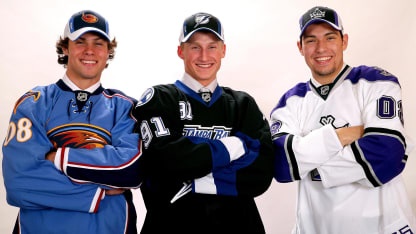
© Getty Images
The St. Louis Blues needed little time to pick Pietrangelo at No. 4.
"With Bogosian being so high on everyone's list and Drew Doughty there and Stamkos, we thought we'd get Alex at four for sure," said Jarmo Kekalainen, then the Blues assistant GM and currently the Columbus Blue Jackets GM. "We had a backup plan, we had a next player in line that we liked a lot, but we were very, very confident we'd get Alex at four."
The New York Islanders were next at No. 5, and that's when an unprecedented amount of wheeling and dealing kicked into high gear.
* * *
Garth Snow and his staff with the Islanders had decided they wanted center Josh Bailey from Windsor of the OHL.
"It wasn't just one attribute," said Snow, the GM at the time. "His vision … we knew he was more of a puck distributor than a goal-scorer. And the high character, the person, was just as impressive for us with the hockey sense and his vision on the ice and his skill set."
Snow said he was confident that he could trade down to the 10-15 range and get Bailey.
His first connection was with the Toronto Maple Leafs, who had the No. 7 pick. The teams exchanged first-round picks, and the Islanders also got the Maple Leafs' 2008 third-round pick (No. 68) and a second-round pick in 2009.
Toronto chose Schenn at No. 5. After Columbus took forward Nikita Filatov at No. 6, Snow traded the No. 7 pick to Nashville for the No. 9 selection and a 2008 second-round pick (No. 40).
"You talk to every team and you see what you're comfortable with," Snow said. "Do you move back three slots? Go from five to nine and see what you can get? We just felt as a staff that instead of trying to go five to nine, if we could get another trade in there it would give us another second-round pick."
New York ended up with three second-rounders and used one (No. 53) on defenseman Travis Hamonic from Moose Jaw of the WHL. He was a top-four defenseman for all seven of his seasons (2010-17) in New York before being traded to the Calgary Flames.
"Most of the strategy was focused on Josh Bailey and then knowing that the second round had some quality players," Snow said. "To get three swings at the ball was something that was appealing to us. Just getting Travis Hamonic with one of the three, any team would take that."
The Predators chose Wilson at No. 7, and after the Coyotes took forward Mikkel Boedker from Kitchener of the OHL at No. 8, the Islanders selected Bailey at No. 9.
Snow said he contemplated trying to move down one more time.
"It was more trepidation doing it again," he said. "That would be the worst, you do it again and you don't get the player. … Didn't feel like taking a risk and doing it again. Josh was there."
As well as Snow had planned things out, there was a moment he feared things could have gone sideways: Bailey's agent set up a meeting between the player and GM at Snow's hotel the night before the draft.
"We know we already want him, we don't want anyone from other teams seeing him with us," Snow said. "He came up to my room. We didn't want to meet in the lobby. We had known with our background checks what Josh was all about character-wise. We obviously liked him a lot as a player. It was more a courtesy to meet with him. And that was really the only player we had met with. … We took a chance even doing the meeting."
* * *
Aside from meeting with Bailey, the Islanders were plenty busy: They made two of the 13 trades in the first round, 12 of them involving picks from that round.
"I don't think there's ever been a situation like that and I don't think it's ever going to happen again," Dorion said.
Edmonton, which had the No. 22 pick, feared one of the trades was about to undo two years of planning to get Regina forward Jordan Eberle, who had been touted years earlier by longtime Oilers scout Loren Davis.
"When Jordan was a 16-year-old, Loren told us, 'Guys, if we ever have a chance to draft Jordan Eberle, make sure we take it,'" said Stu MacGregor, then Edmonton's director of amateur scouting. "It's unfortunate Loren had passed away before the pick. But we remembered that because [of] Loren's experience and being such a good man, we took it to heart and we were really excited to get Jordan."
That excitement turned to panic when the Washington Capitals made a trade with the New Jersey Devils to move up from No. 23 to No. 21.
"[Capitals] head scout Ross Mahoney at the time lived in Regina," MacGregor said. "Our guys are going, 'Ross is going to take Eberle,' because Ross had been very active over the years in taking Western Hockey League guys, especially players from around the Regina/Moose Jaw area, so we said we lost him."
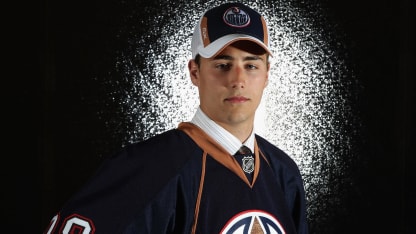
© Getty Images
MacGregor's fears were unfounded; Washington instead selected Frolunda forward Anton Gustafsson, who never played in the NHL.
"Hard-working kid, had good sense, pretty big body (6-2, 194)," said Mahoney, now a Capitals assistant general manager. "He skates well. We were drawn by his sense and his skating and compete level and his leadership. They were all positives.
"That's not a knock on Eberle at all. Gustafsson was one of the guys we targeted and we were looking to draft."
That left Eberle for the Oilers to select with a pick they acquired when they traded defenseman Chris Pronger to the Ducks on July 3, 2006.
"It was a pretty good day for us," MacGregor said. "We were pretty excited."
Eberle lived up to Davis' expectations, scoring at least 20 goals five times in seven seasons with the Oilers. Traded to the Islanders on June 22, 2017, he scored 25 goals this season.
"He's been very consistent," said MacGregor, now a scout for the Dallas Stars. "He had the 30-goal season (34 in 2011-12), but he's been in that range of 20, 25 goals over a long period of time."
After getting Gustafsson, Washington saw another player it had rated highly was available: defenseman John Carlson from Indiana of the United States Hockey League. The Capitals sent defenseman Steve Eminger and a 2008 third-round selection (No. 84) to the Philadelphia Flyers for the No. 27 pick.
Eminger, selected by Washington at No. 12 in the 2002 NHL Draft, had six goals in 214 NHL games over five seasons to that point. The Capitals saw a brighter future in Carlson and picked him.
"It's never easy to trade a player you have in your system," Mahoney said. "We just thought that the upside of John was going to be pretty high. He had a lot of offense to his game and brought that to us. And he was a right-handed shot. We thought John could contribute to the power play in the future."
* * \
The story of the first round of the 2008 draft can't be written without mentioning the things that nearly happened.
Scott Howson, the Blue Jackets GM at the time, said he tried to trade up from No. 6 to select one of the top defensemen.
"We talked about trying to move up to two or three and it just wasn't even close," he said. "It really wasn't an option. Doughty obviously [was a target], and then we really liked Bogosian too. We liked Bogosian a lot."
The Blue Jackets instead selected Filatov, who played 53 NHL games over four seasons with Columbus and Ottawa before returning to his native Russia.
The Flyers reached out to the Predators with the hope of acquiring the No. 15 pick and selecting Karlsson. They offered forward R.J. Umberger, who scored 10 goals in 17 games during the 2008 Stanley Cup Playoffs, but Nashville said no.
"We liked [Karlsson]," said Flyers president Paul Holmgren, then Philadelphia's GM. "Our guys, and a lot of teams, fell in love with him at the [World Under-18 Championship], where he had a great tournament."
The Flyers traded Umberger to the Blue Jackets for the No. 19 pick and selected defenseman Luca Sbisa, now a 10-year NHL veteran and member of the Vegas Golden Knights.
And the Ducks, the team Karlsson thought would take him at No. 17, selected a different defenseman: Jake Gardiner from Minnetonka (Minn.) High School.
"All I remember from that draft day was our guys really liked Jake Gardiner," said Brian Burke, the Anaheim GM at the time, of the current Maple Leafs defenseman. "We weren't sure he was a defenseman. He'd played forward his whole life until his draft year, when they made him a defenseman. We said we could always move him back [to forward] if it didn't work out.
"We thought he was a defenseman but weren't sure, but we said if we're taking him, we're taking him as a defenseman. We loved him, and I traded for him again when I got to Toronto (as GM), so I was pretty high on him."
\ * *
Of course, there are plenty of notable things that did happen, at the draft and since:
Stamkos has scored 348 goals, second in the NHL since that draft to Capitals forward Alex Ovechkin (444). His 60 goals in 2011-12 are the most in a season since he entered the NHL in 2008-09, and he's won the Rocket Richard Trophy twice (2010, 2012) as the NHL's leading goal-scorer.
Twelve defensemen were selected, tied for the second-most in a first round (also done in 2009, 2005 and 1996) and one off the record of 13 in 2012.
Karlsson has 518 points (126 goals, 392 assists), most among NHL defensemen since 2008-09, and won the Norris Trophy in 2012 and 2015.
Doughty won the Norris in 2016, has been a finalist four times and helped the Kings win the Stanley Cup a second time in 2014. Myers, now of the Winnipeg Jets, was selected by the Sabres at No. 12 and won the Calder Trophy, given to the NHL's top rookie, in 2010. Carlson helped the Capitals win the Stanley Cup this season after leading NHL defensemen with 68 regular-season points (15 goals, 53 assists) and 20 playoff points (five goals, 15 assists). Pietrangelo has become a No. 1 defenseman, spending all 10 of his NHL seasons with St. Louis.
The players picked in the first round have made the NHL First All-Star team a combined five times (Karlsson four, Doughty one) and the Second All-Star team six times (Stamkos, Doughty and Pietrangelo twice each), and played in the NHL All-Star Game 17 times, including five each by Stamkos and Karlsson, and four times for Doughty. Eberle (2012), Pietrangelo (2018) and Bailey (2018) have each played in it once.
"A lot of guys in that class have had very good NHL careers and are still going very strong," Dorion said. "[A] lot of guys are in their primes.
"I think it says a lot about the quality of the draft."
NHL.com staff writers Mike Zeisberger and Lisa Dillman, and correspondent Callum Fraser, contributed to this report.
